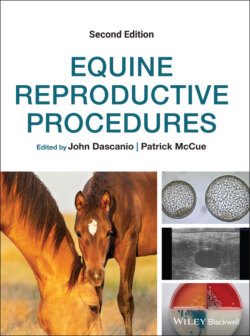Читать книгу Equine Reproductive Procedures - Группа авторов - Страница 76
Оглавление25 Evaluation of the Mammary Gland
Patrick M. McCue
Equine Reproduction Laboratory, Colorado State University, USA
Introduction
The mammary gland plays a key role in allowing the fetus to survive outside the uterus. It is responsible for providing the neonate with colostral antibodies critical to survival and supplies nutrition to the foal during the first few months of life. The equine mammary gland is located high in the inguinal region of the mare. The equine mammary gland is divided into left and right halves by a connective tissue septum, each with a glandular body and teat. The glandular portion of each half is further divided by fibroelastic capsules into cranial and caudal lobes. Each of the two teats serves a cranial and caudal lobe of mammary tissue and has two teat orifices (Figure 25.1).
Abnormalities of the equine mammary gland include agalactia, premature lactation, inappropriate lactation, and mastitis. Less common issues include abscessation, neoplasia, and trauma.
Figure 25.1 Mammary gland of a mare. Note the two teat orifices visible on the end of the right teat.
Equipment and Supplies
Exam glove, alcohol swabs, sterile container (red top tube, urine cup, etc.), culture transport system, glass microscope slides, cytology stain, microscope, ultrasound.
Techinque
A visual assessment of the mammary gland should be performed initially. Udder size, shape, and symmetry should be assessed and related to the reproductive status of the mare (non‐pregnant, late‐term pregnant, postpartum, post‐weaning, etc.).
The pregnant mare’s udder will increase in size over the last 4–6 weeks of gestation. Nulliparous mares may not have much udder development until 1–2 weeks prior to parturition or even not until parturition. Fescue toxicosis should be ruled out in cases of poor udder development.
Foals born to mares with abnormally large teats may have difficulty nursing due to an inability to form a proper suction. These foals should be watched closely for adequate ingestion of milk and weighed daily to ensure intake.
A manual examination of the udder should be performed next. A hot, swollen, painful quarter is consistent with acute mastitis (Figure 25.2). In addition, edema may be present cranial to the udder in affected mares (Figure 25.3). Edema may also be present in normal mares near foaling as the blood vessels to the udder develop, due to the position of the in utero foal decreasing venous return and due to mare inactivity in late pregnancy.
Mares with inappropriate lactation or galactorrhea, such as may occur secondary to pituitary pars intermedia dysfunction, often have a small to moderate amount of mammary secretion produced in all four quarters and the overall gland is not hot or painful (Figure 25.4). Sometimes, normal, older multiparous mares may have large teat or gland cisterns that fill with secretions without active lactation or pregnancy.Figure 25.2 Enlargement of the right rear quarter of a mare secondary to mastitis.Figure 25.3 Edema cranial to the udder in a mare with mastitis.Figure 25.4 Enlargement of the entire udder in a mare with galactorrhea secondary to pituitary pars intermedia dysfunction.
Mammary fluid should be expressed and the character of the fluid assessed. Mastitic fluid is typically thick, white to slightly yellow in color (Figure 25.5), and may be blood tinged.
A cytologic evaluation of the mammary fluid may be indicated if mastitis or neoplasia is suspected. Mare milk produced during normal lactation and mammary secretion from a non‐pregnant, non‐foaling mare with inappropriate lactation should not have a large number of white blood cells on cytology. In contrast, white blood cells are abundant in mares with mastitis (Figure 25.6).
The teat should be cleaned of dirt/debris and the end disinfected with an alcohol swab prior to expression of milk for bacteriological culture (see Chapter 106).
Secretions should be collected from the teat into a sterile container.Figure 25.5 Thick inflammatory fluid expressed from the udder of a mare with mastitis.Figure 25.6 Cytologic evaluation of mammary fluid from a mare with mastitis. Note the large number of degenerated white blood cells (arrow).
A culture of mammary secretion should be performed if mastitis is suspected. Equine mastitis is usually bacterial in origin and the most common organisms are Streptococcus equi subspecies zooepidemicus and Staphylococcus species. Gram‐negative organisms such as Escherichia coli and Klebsiella species are less commonly isolated.
An ultrasound examination may be performed following manual assessment of the mammary gland to evaluate a region for a potential mammary tumor or abscess. Application of isopropyl alcohol to the skin may be needed to provide adequate probe contact.
Biopsy of the mammary gland may be indicated for histologic verification of neoplasia. However, tumors of the equine mammary gland are rare and consequently biopsies of the udder are rarely performed.
At weaning the foal should be removed from the mare and the mare should not be milked. The active pressure within the aveoli will cause milk production to cease. Some mares may experience slight pain for 1–2 days upon removal of the foal.
Further Reading
1 Gee EK, McCue PM. 2011. Mastitis. In: McKinnon AO, Squires EL, Vaala WE, Varner DD (eds). Equine Reproduction, 2nd edn. Ames, IA: Wiley Blackwell, pp. 2738–41.
2 McCue PM, Sitters S. 2011. Lactation. In: McKinnon AO, Squires EL, Vaala WE, Varner DD (eds). Equine Reproduction, 2nd edn. Ames, IA: Wiley Blackwell, pp. 2277–90.
3 Waldridge BM, Ward TA. 1999. Ultrasound examination of the equine mammary gland. Eq Pract 21: 10–13.
